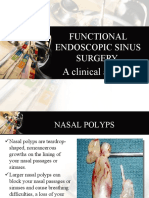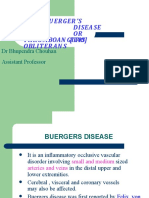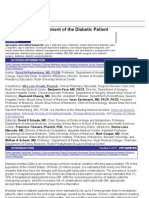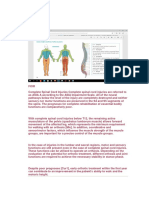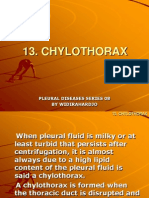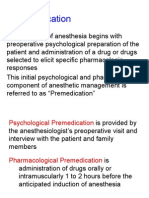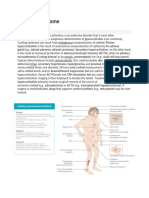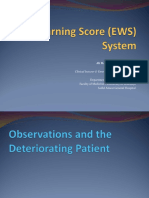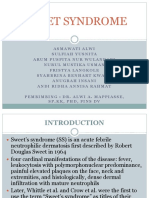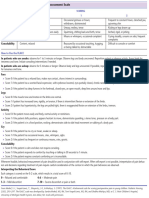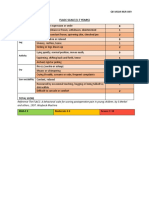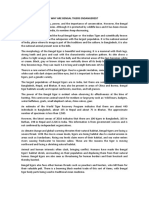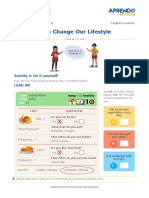FLACC Scale
FLACC Scale
Uploaded by
N Novi Kemala SariCopyright:
Available Formats
FLACC Scale
FLACC Scale
Uploaded by
N Novi Kemala SariOriginal Description:
Copyright
Available Formats
Share this document
Did you find this document useful?
Is this content inappropriate?
Copyright:
Available Formats
FLACC Scale
FLACC Scale
Uploaded by
N Novi Kemala SariCopyright:
Available Formats
r-FLACC Scale
Face, Legs, Activity, Cry, Consolability
0 1 2
No particular expression Occasional grimace or Consistent grimace or
FACE or smile frown, withdrawn or frown; frequent/constant
disinterested; appears quivering chin; clenched
Individualized behavior: sad or worried jaw; distressed-looking
___________________ face; expression of
fright or panic
0 1 2
Normal position or Uneasy, restless, tense; Kicking, or legs drawn
LEGS relaxed; usual tone & occasional tremors up; marked increase in
motion to limbs spasticity, constant
Individualized behavior: tremors or jerking
___________________
0 1 2
Lying quietly, normal Squirming, shifting Arched, rigid or jerking,
ACITIVTY position, moves easily, back/forth, tense or severe agitation, head
regular & rhythmic guarded movements, banging, shivering,
Individualized behavior: respirations mildly agitated, shallow breath holding, gasping
___________________ splinting respirations, or sharp intake of
intermittent sighs breaths, severe splinting
0 1 2
No cry/verbalization Moans or whimpers, Crying steadily, screams
CRY occasional complaint, or sobs,
occasional verbal frequent complaints,
Individualized behavior: outburst or grunt repeated outbursts,
___________________ constant grunting
0 1 2
Content or relaxed Reassured by occasional Difficult to console or
CONSOLABILITY touching, hugging or comfort, pushing away
being talked to, caregiver, resisting care
Individualized behavior: distractible or comfort measures
___________________
Instructions for Use: Interpreting the Score
1. Rate patient in each category 0 Relaxed & comfortable
2. Add the scores together 1 – 3 = Mild discomfort
3. Document the total pain score 4 – 6 = Moderate pain
7 –10 = Severe pain or discomfort
or both
r-FLACC Scale
Face, Legs, Activity, Cry, Consolability
How to use the revised FLACC (r-FLACC) scale
In patients who are awake: observe for 1-5 minutes or longer. Observe legs and body uncovered.
Reposition patient or observe activity. Assess body for tenseness and tone. Initiate consoling interventions
if needed.
In patients who are asleep: observe for 5 minutes or longer. Observe body and legs uncovered. If possible,
reposition the patient. Touch the body and assess the tenseness and tone.
In patients with cognitive impairment, obtain parent input on individualized behaviors for each category
prior to assessment. Examples of behaviors may include agitation, verbal outbursts, tremors, shivering,
hypertonicity or increased spasticity, breath holding, and gasping, and are italicized below.
Face
• Score 0 if the patient has a relaxed face, makes eye contact, shows interest in surrounding
• Score 1 if the patient has a worried facial expression, with eyebrows lowered, eyes partially
closed, cheeks raised, mouth pursed
• Score 2 if the patient has deep furrows in the forehead, closed eyes an open mouth, deep lines
around nose and lips; distressed-looking face; expression of fright or panic
Legs
• Score 0 if the muscle tone and the motion in the limbs are normal
• Score 1 if patient has increased tone, rigidity, or tension; if there is intermittent flexion or
extension of limbs; occasional tremors
• Score 2 if the patient has hypertonicity, the legs are pulled tight, there is exaggerated flexion or
extension of the limbs, tremors; marked increase in spasticity, constant tremors or jerking
Activity
• Score 0 if the patient moves easily and freely, normal activity or restrictions; regular, rhythmic
respirations
• Score 1 if the patient shifts positions, appears hesitant to move, demonstrates guarding, a tense
torso, pressure on a body part; tense or guarded movements; mildly agitated (e.g. head back and
forth, aggression); shallow, splinting respirations, intermittent sighs
• Score 2 if the patient is fixed in a position, rocking; demonstrates side-to-side head movement or
rubbing of a body part; severe agitation; head banging; shivering (not rigors); breath holding,
gasping or sharp intake of breaths, severe splinting
Cry
• Score 0 if the patient has no cry or moan, awake or asleep
• Score 1 if the patient has occasional moans, cries, whimpers, sighs; occasional verbal outburst or
grunt
• Score 2 if the patient has frequent or continuous moans, cries, grunts; repeated outbursts, constant
grunting
Consolability
• Score 0 if the patient is calm and does not require consoling
• Score 1 if the patient responds to comfort by touching or talking in <30 seconds to 1 minute
• Score 2 if the patient requires constant comforting or is inconsolable; pushing away caregiver,
resisting care or comfort measures
Each category is scored on the 0-2 scale, which results in a total possible score of 0-10. 0 = Relaxed and
Comfortable, 1-3 = Mild discomfort, 4-6 = Moderate pain, 7-10 = Severe pain or discomfort or both
Revised March 11, 2009
You might also like
- ECG Localization of Myocardial Infarction IscheDocument1 pageECG Localization of Myocardial Infarction IscheAsif ArahimNo ratings yet
- Mudgal PuranDocument9 pagesMudgal Puranarjun_chip_c0% (1)
- FLACC Scale (Face, Legs, Activity, Cry, Consolability Scale) ScoreDocument1 pageFLACC Scale (Face, Legs, Activity, Cry, Consolability Scale) ScoreAngieNo ratings yet
- Analgesi Dan Sedasi Di IcuDocument32 pagesAnalgesi Dan Sedasi Di IcuWidi Yuli HariantoNo ratings yet
- Emergence Delirium in Pediatric PatientsDocument6 pagesEmergence Delirium in Pediatric PatientsJZ100% (1)
- Emergence Delirium in Pediatric Patients: Valerie Au, M.D. Andrew Infosino, M.DDocument34 pagesEmergence Delirium in Pediatric Patients: Valerie Au, M.D. Andrew Infosino, M.DMorad SatariNo ratings yet
- MNJ ToastDocument4 pagesMNJ ToastRichard SuherlimNo ratings yet
- General Anesthetic 2016Document33 pagesGeneral Anesthetic 2016Harsha Maheshwari100% (1)
- Update On The Management of LaryngospasmDocument6 pagesUpdate On The Management of LaryngospasmGede Eka Putra NugrahaNo ratings yet
- Postural Assessment Scale For Stroke Patients 2Document19 pagesPostural Assessment Scale For Stroke Patients 2api-323356666No ratings yet
- Pediatric Shock (PICUCOURSE)Document40 pagesPediatric Shock (PICUCOURSE)surasuarezlopezNo ratings yet
- 3-Approach To Epigastric PainDocument62 pages3-Approach To Epigastric PainAbdulrahman NanakaliNo ratings yet
- Upper GIT 1Document18 pagesUpper GIT 1Zuhra JabeenNo ratings yet
- Hypertensive Emgerencies 2021Document19 pagesHypertensive Emgerencies 2021Faranitach AiniNo ratings yet
- Nociplastic Pain: Focus On Pathophysiology & Implication On Pain ManagementDocument34 pagesNociplastic Pain: Focus On Pathophysiology & Implication On Pain ManagementMarest AskynaNo ratings yet
- Functional Endoscopic Sinus Surgery: A Clinical AbstractDocument17 pagesFunctional Endoscopic Sinus Surgery: A Clinical AbstractYel CuencaNo ratings yet
- Cikini Pengelolaan Nyeri FinalDocument85 pagesCikini Pengelolaan Nyeri FinalisabellaruthhhNo ratings yet
- Bu Erger 'S Disea Se OR Thromboan Gitis Obliter An S (TAO) : DR Bhupendra Chouhan Assistant ProfessorDocument19 pagesBu Erger 'S Disea Se OR Thromboan Gitis Obliter An S (TAO) : DR Bhupendra Chouhan Assistant ProfessorAnupam MantriNo ratings yet
- Conus Medullaris Vs Cauda Equina SyndromeDocument1 pageConus Medullaris Vs Cauda Equina SyndromecpradheepNo ratings yet
- Hypertension Is ADocument4 pagesHypertension Is Aperny karaiNo ratings yet
- 133 - Neurology Pathology - Midbrain Lesions Benedikt, Weber, Claude, Parinaud SyndromeDocument5 pages133 - Neurology Pathology - Midbrain Lesions Benedikt, Weber, Claude, Parinaud Syndromeice.bear.wolfoNo ratings yet
- Perioperative Management of The Diabetic PatientDocument9 pagesPerioperative Management of The Diabetic PatientFauzi Abdillah SusmanNo ratings yet
- Hemorrhagic StrokeDocument57 pagesHemorrhagic StrokefarhanomeNo ratings yet
- Elbow ROM Exercises: 33 Sewall Street Portland, ME 04102Document1 pageElbow ROM Exercises: 33 Sewall Street Portland, ME 04102Melisa Agustina TobarNo ratings yet
- Surviving Sepsis Campaign 2021 Adult Guidelines Learning SlidesDocument29 pagesSurviving Sepsis Campaign 2021 Adult Guidelines Learning SlidesLichte ChristianNo ratings yet
- Klasifikasi Dan Pengukuran ASIADocument8 pagesKlasifikasi Dan Pengukuran ASIAannisayaNo ratings yet
- ChylothoraxDocument8 pagesChylothoraxMaral Bimanti FebrilinaNo ratings yet
- POEMS SyndromeDocument13 pagesPOEMS SyndromeFernando Suarez ChumaceroNo ratings yet
- Chvostek's Sign and Carpopedal Spasm NEJM APRIL 2009 PDFDocument1 pageChvostek's Sign and Carpopedal Spasm NEJM APRIL 2009 PDFAnonymous uVinWXfo4No ratings yet
- Neurological Examination 3Document46 pagesNeurological Examination 3VIKAS PUNIANo ratings yet
- The Liability Management TheoryDocument9 pagesThe Liability Management Theoryo8160310% (1)
- Trigeminal NeuralgiaDocument23 pagesTrigeminal Neuralgiaekiferdianto100% (1)
- Penetrating Chest Trauma PDFDocument5 pagesPenetrating Chest Trauma PDFFerina FernandaNo ratings yet
- Nausea and Vomiting (Algorithm) PDFDocument2 pagesNausea and Vomiting (Algorithm) PDFAnggie Anggriyana0% (1)
- Referat HNPDocument17 pagesReferat HNPROSSA100% (1)
- PremedicationDocument9 pagesPremedicationdrhiwaomer100% (3)
- Seminar HD-RSUD Sleman 2019Document36 pagesSeminar HD-RSUD Sleman 2019herkamaya100% (1)
- Benign Prostatic Hyperplasia.Document5 pagesBenign Prostatic Hyperplasia.Mas HaqiNo ratings yet
- Spondylitis TBDocument33 pagesSpondylitis TBYohana KoliNo ratings yet
- Systemic Lupus Erythematosus: Pathogenesis and Clinical FeaturesDocument30 pagesSystemic Lupus Erythematosus: Pathogenesis and Clinical FeaturesOrion JohnNo ratings yet
- Diagnosis of Gastrointestinal Bleeding in AdultsDocument8 pagesDiagnosis of Gastrointestinal Bleeding in AdultsSaeed Al-YafeiNo ratings yet
- MacCallan's Classification of TrachomaDocument1 pageMacCallan's Classification of TrachomaYusri ArifNo ratings yet
- Cushing Syndrome: (Hypercortisolism)Document7 pagesCushing Syndrome: (Hypercortisolism)Daniela100% (1)
- Dizziness: Presented By: Rawan Shaher Al-AssafDocument47 pagesDizziness: Presented By: Rawan Shaher Al-AssafRazan Shaher Al Assaf100% (1)
- Kul Sem 4 Heat Stroke N Fever UHT 2016Document63 pagesKul Sem 4 Heat Stroke N Fever UHT 2016NandaSuryaWijayaNo ratings yet
- 589.ushio Therabeam UV308Document2 pages589.ushio Therabeam UV308taufik kasimNo ratings yet
- DD Case Report Elbow DislocationDocument33 pagesDD Case Report Elbow DislocationKurniawan Nur IhsanNo ratings yet
- Workshop On Early Warning Score System - Ali HaedarDocument61 pagesWorkshop On Early Warning Score System - Ali HaedarGede Kevin Adhitya SaputraNo ratings yet
- Pressure Ulcer Prevention & Management: Wocare ClinicDocument20 pagesPressure Ulcer Prevention & Management: Wocare ClinicShoahir RustanNo ratings yet
- Ohtahara Syndrome: Corticosteroids (Prednisolone or ACTH) Are Occasionally HelpfulDocument2 pagesOhtahara Syndrome: Corticosteroids (Prednisolone or ACTH) Are Occasionally HelpfulidscribddotcomNo ratings yet
- Olanzapine Vs AripiprazoleDocument8 pagesOlanzapine Vs AripiprazoleDivaviyaNo ratings yet
- Trigeminal NeuralgiaDocument2 pagesTrigeminal NeuralgiaBryan Lloyd RayatNo ratings yet
- HIPOMAGNESEMIADocument11 pagesHIPOMAGNESEMIAInsan IlmanNo ratings yet
- Systemic Effects of Perinatal AsphyxiaDocument10 pagesSystemic Effects of Perinatal AsphyxiaJaner Banos100% (1)
- Headache OverviewDocument29 pagesHeadache OverviewFiqna SyaniNo ratings yet
- Subdural Hygroma Different Treatment Modalities AnDocument13 pagesSubdural Hygroma Different Treatment Modalities AnDewan Shamsul AsifNo ratings yet
- Mojahid Sheet CompleteDocument176 pagesMojahid Sheet CompleteAdams AdamNo ratings yet
- Sweet Syndrome EnglishDocument19 pagesSweet Syndrome EnglishAsma AlwiNo ratings yet
- Pain FLACC Behavioural Pain Assessment Scale 2015Document1 pagePain FLACC Behavioural Pain Assessment Scale 2015Bela RonaldoeNo ratings yet
- Pain Scale FLACC - 2Document1 pagePain Scale FLACC - 2hanakhraiseNo ratings yet
- Pediatric Pain ScaleDocument2 pagesPediatric Pain ScaleSathish HaranNo ratings yet
- Alcohol Related Emergencies (ALS)Document10 pagesAlcohol Related Emergencies (ALS)Ilyes FerenczNo ratings yet
- Withholding Tax 101Document82 pagesWithholding Tax 101Maria GinalynNo ratings yet
- CBexam Mockexam Draft01Document5 pagesCBexam Mockexam Draft01Mark Lord Morales BumagatNo ratings yet
- Product Data Sheet: C-Bus® Network Automation Controller, Bacnet, Modbus, Ip, 6M Din Mount, 24V DCDocument2 pagesProduct Data Sheet: C-Bus® Network Automation Controller, Bacnet, Modbus, Ip, 6M Din Mount, 24V DCErika Jeanne Porlas JimenezNo ratings yet
- Group3 - BALINGIT, FRANCISCO, HAIN, JADWANI, JAYME - 11 - 1 - PR 1 Chapter 1Document15 pagesGroup3 - BALINGIT, FRANCISCO, HAIN, JADWANI, JAYME - 11 - 1 - PR 1 Chapter 1Jann Arden F. JADWANINo ratings yet
- EM BokashiDocument10 pagesEM BokashiPriyono ArieNo ratings yet
- Mosquito Repellant SprayDocument10 pagesMosquito Repellant SprayCharles Vince SuanNo ratings yet
- A Japanese Sake Brewery Making Decisions: Supply Chain Forum January 2013Document10 pagesA Japanese Sake Brewery Making Decisions: Supply Chain Forum January 2013Gerardo Alfredo Encarnacion RamirezNo ratings yet
- Feasibility 11 13Document17 pagesFeasibility 11 13Eniam SotnasNo ratings yet
- Non Returne ValvesDocument22 pagesNon Returne ValvesSH1961No ratings yet
- 2015 Translucency of Esthetic Dental Restorative CADCAM MaterialsDocument7 pages2015 Translucency of Esthetic Dental Restorative CADCAM MaterialsGeorgi AnaNo ratings yet
- Murrell2008 Glasgow DolorDocument6 pagesMurrell2008 Glasgow DolorEdwardNo ratings yet
- ITC Launches New Brand 'Farmland'Document10 pagesITC Launches New Brand 'Farmland'Sauro ShuvroNo ratings yet
- Water Level Indicator FinalDocument40 pagesWater Level Indicator Finalritesh chauhan100% (1)
- Chapter 1 - MultivariateDocument30 pagesChapter 1 - MultivariateYash Gajwani100% (1)
- Why Are Bengal Tigers EndangeredDocument2 pagesWhy Are Bengal Tigers EndangeredGonzalo BurgaNo ratings yet
- Copia de Exp8-Ebr-Secundaria-3y4-Seguimosaprendiendo-Ingles-Activity4Document4 pagesCopia de Exp8-Ebr-Secundaria-3y4-Seguimosaprendiendo-Ingles-Activity4karel maytaNo ratings yet
- Redpost Pasteurization Monitor Rpu Haffmans Leaflet v2102 enDocument2 pagesRedpost Pasteurization Monitor Rpu Haffmans Leaflet v2102 enFilipe FerreiraNo ratings yet
- Electric Linear Actuators New ITL (20180105-1)Document9 pagesElectric Linear Actuators New ITL (20180105-1)aniketNo ratings yet
- Rockefeller Annual ReportDocument66 pagesRockefeller Annual ReportIrvan GarutNo ratings yet
- 7TH ScienceDocument2 pages7TH ScienceMuhammad Qadir RafiqueNo ratings yet
- Name: Aballa, Mary Ann E. Grade & Section: 12 - Erickson Psychosocial Moratorium On Something SpectacularDocument2 pagesName: Aballa, Mary Ann E. Grade & Section: 12 - Erickson Psychosocial Moratorium On Something SpectacularMary Ann Elacion AballaNo ratings yet
- Multi-Purpose Loan (MPL) Application FormDocument2 pagesMulti-Purpose Loan (MPL) Application FormBecca BelenNo ratings yet
- Vocabulary: Science Grade 6: ElectricityDocument11 pagesVocabulary: Science Grade 6: ElectricityKyo ToeyNo ratings yet
- Studiu 1-Attachment Insecurity and Infidelity in Marriage Do Studies of DatingDocument11 pagesStudiu 1-Attachment Insecurity and Infidelity in Marriage Do Studies of DatingGiuliutza FranCesca100% (1)
- United States Patent: Chaignon Et Al. Sep. 14, 2004Document6 pagesUnited States Patent: Chaignon Et Al. Sep. 14, 2004Alexander Franco CastrillonNo ratings yet
- Modernizing The US Data System An Introduction To NERISDocument12 pagesModernizing The US Data System An Introduction To NERISLexipol_Media_GroupNo ratings yet
- Questionnaire 2Document1 pageQuestionnaire 2Anonymous fvY2BzPQVx89% (9)
- Eric Desena: 614 Bristol Street, Sarnia ON N7S 5E1Document3 pagesEric Desena: 614 Bristol Street, Sarnia ON N7S 5E1Eric DesenaNo ratings yet















